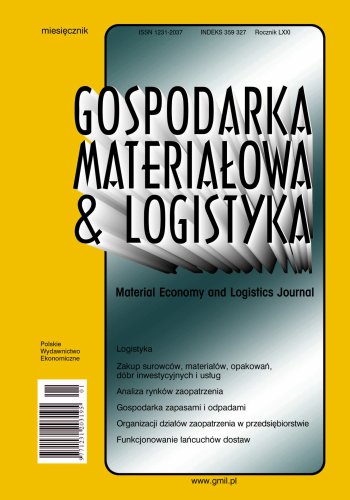Teamwork in the supply chain – a systematic and bibliometric analysis (part 1)
The success of supply chains depends primarily on integrating and coordinating the activities of network participants. Many supplier companies are shifting toward team-based structures to manage the boundaries with their customers. One of the possibilities of the operational implementation of cooperation in the supply chain is the appointment of teams in the network structure. Teamwork is a specific social group, consisting of at least two people, subject to the same impact, consciously interacting with one another, perceiving themselves as members of a specific group and identifying with it, as well as having a common goal, shared norms and creating a characteristic structure (fulfilling complementary roles). Situation caused by COVID-19 forced a change in defining and functioning of supply chains. It is also a moment of very dynamic development of work and cooperation in a remote environment, which impacted the functioning of teamwork in the supply chain. The paper is composed of two parts and aims to orient researchers who are new to collaborative work in supply chain research. The first article is structured as follows: the systematic literature review procedure is presented, then the bibliometric analysis is conducted, an in-depth analysis of journals and articles is performed with use of the Treecloud tool and VOSviewer software to analyse the selected papers.
References
References/Bibliografia
Ancona, D. G., & Caldwell, D. F. (1992). Demography and design: Predictors of new product team performance. Organization Science, 3(3), 321–341. https://doi.org/10.1287/orsc.3.3.321
Barrat, M. (2004). Understanding the meaning of collaboration in the supply chain. Supply Chain Management, 9(1), 30–42. https://doi.org/10.1108/13598540410517566
Barratt, M. A., & Oliveira, A. (2001). Exploring the experiences of collaborative planning: The enablers and inhibitors. International Journal of Physical Distribution & Logistics Management, 31(2), 266–289. https://doi.org/10.1108/09600030110394932
Bennett, M., Brown, R. D., Galster, S. M., Dukes, A. W., & Nelson, W. T. (2008). Managing a supply chain: What communication patterns might divulge about information availability and team performance. Human Factors and Ergonomics Society Annual Meeting Proceedings. https://doi.org/10.1177/154193120805201930
Bresman, H. (2010). External learning activities and team performance: A multimethod field study. Organization Science, 21(1), 81–86. https://doi.org/10.1287/orsc.1080.0413
Cao, M., & Zhang, Q. (2011). Supply chain collaboration: Impact on collaborative advantage and firm performance. Journal of Operations Management, 29(3), 163–180. https://doi.org/10.1016/j.jom.2010.12.008
Cardozo, R. N., Shannon, H. S., & Roering, K. J. (1992). Proactive strategic partnerships: A new business market strategy. Journal of Business & Industrial Marketing, 7(1), 51–63. https://doi.org/10.1108/eum0000000002761
Cummings, J. N. (2004). Work groups, stuructural diversity, and knowledge sharing in a global organization. Management Science, 50, 352–364. https://doi.org/10.1287/mnsc.1030.0134
Czakon, W. (2011). Metodyka systematycznego przeglądu literatury. Przegląd Organizacji, (3), 57–61. https://doi.org/10.33141/po.2011.03.13
van Eck, N. J., & Waltman, L. (2013). manual. Univeristeit Leiden, September. http://www.vosviewer.com/documentation/Manual_VOSviewer_1.6.1.pdf
Fawcett, S. E., Magnan, G. M., & McCarter, M. W. (2008). A Three-stage implementation model for supply chain collaboration.
Journal of Business Logistics, 29(1), 93–112. https://doi.org/10.1002/j.2158-1592.2008.tb00070.x
Franke, H., Foerstl, K., & Heese, H. S. (2020). The interaction effect of goal misalignment and metaknowledge distribution on team decision making in operations and supply chain management. Decision Sciences. https://doi.org/10.1111/deci.12439
Fugate, B. S., Mentzer, J. T., & Stank, T. P. (2010). Logistics performance: Efficiency, effectiveness and differentiation. Journal of Business Logistics, 31(1), 43–62. https://doi.org/10.1002/j.2158-1592.2010.tb00127.x
Gambette, P., & Véronis, J. (2009). Visualising a text with a tree cloud. IFCS'09: International Federation of Classification Societies Conference, 561–569. https://doi.org/10.1007/978-3-642-10745-0_61
Hansen, M. T. (1999). The search-transfer problem: The role of weak ties in sharing knowledge across organizational subunits. Administrative Science Quarterly, 44, 82–111. https://doi.org/10.2307/2667032
Kinder, T. (2003). Go with the flow – a conceptual framework for supply relations in the era of the extended enterprise. Research Policy, 32(3), 503–523. https://doi.org/10.1016/s0048-7333(02)00021-5
Lazer, D., & Friedman, A. (2007). The network structure of exploration and exploitation. Administrative Science Quarterly, 52(4), 667–694. https://doi.org/10.2189/asqu.52.4.667
Levy, Y., & Ellis, T. J. (2006). A systems approach to conduct an effective literature review in support of information systems research. Informing Science. International Journal of an Emerging Transdiscipline, 9, 181–212. https://doi.org/10.28945/479
Madani, M., & Rungsrisawat, S. (2019). The knowledge sharing and the relationship between efficient team and supply chain management. Polish Journal of Management Studies, 20(1). https://doi.org/10.17512/pjms.2019.20.1.23
Marrone, J. A., Tesluck, P. E., & Carson, J. B. (2007). A multilevel investigation of antecedents and consequences of team member boundary spanning behavior. Academy of Management Journal, 50, 1423–1439. https://doi.org/10.5465/amj.2007.28225967
Min, S., Roath, A. S., Daugherty, P. J., Genchev, S. E., Chen, H., Arndt, A. D., & Richey, G. (2005). Supply chain collaboration: What's happening? The International Journal of Logistics Management, 16(2), 237–256. https://doi.org/10.1108/09574090510634539
Oliver, C. (1990). Determinants of interorganizational relationships: Integration and future directions. Academy of Management Review, 15, 241–265. https://doi.org/10.5465/amr.1990.4308156
Perry, M., Pearce, C. L., & Sims, H. P. (1999). Empowered selling teams: How shared leadership can contribute to selling team outcomes? Journal of Personal Selling & Sales Management, 14(3), 35–51.
Sekaran, U., & Bougie, R. (2010). Research methods for business: A skill-building approach. (5th ed.). John Wiley & Sons.
Shetach, A. (2014). Supply chain management of teamwork: Six guidelines for success. Team Performance Management, 20(3/4), 178–190. https://doi.org/10.1108/tpm-09-2013-0030
Shi, X., & Liao, Z. (2013). The mediating effects of interfirm business process integration and joint teamwork on firm performance in supply chains. Asia Pacific Journal of Management, 30, 1243–1264. https://doi.org/10.1007/s10490-012-9308-6
Stank, T. P., Crum, M., & Arango, M. (1999). Benefits of inter-firm co-ordination in food industry supply chains. Journal of Business Logistics, 20(2), 21–41.
Stock, R. M. (2006). The mediating effects of interfirm business process integration and joint teamwork on firm performance in supply chains. Journal of the Academy of Marketing Science, 34(4), 588–599.
Wageman, R., Gardner, H., & Mortensen, M. (2012). The changing ecology of teams: New directions for teams research. Journal of Organizational Behavior, 33, 301–315. https://doi.org/10.1002/job.1775

